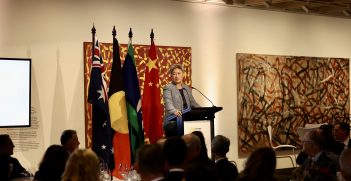From Red to Purple, Green and White: Politics and International Women’s Day

From the red of its socialist and communist origins to the inclusive, global focus of its contemporary tricolour, the story of International Women’s Day is one of cross-border collaboration and political activism.
When attending International Women’s Day (IWD) breakfasts and lunches around 8 March, few think about the politics of international socialism. But this is where IWD had its origins, long before it was endorsed by the United Nations and became a worthy fundraising vehicle for women’s empowerment projects.
The origins of IWD lie in the distrust of the international socialist movement for women’s suffrage and for those ‘bourgeois women’s righters’ led by Emmeline Pankhurst in London. Many male socialists believed that women were too influenced by religion and would vote conservatively.
However Clara Zetkin, a leading figure in the German Social Democratic Party, thought differently. She believed the answer to the problem of women being lured away from the class struggle was for the socialist parties themselves to take up the cause of women’s rights. In 1907, she organised an international conference of socialist women, in conjunction with a meeting of the Second International in Stuttgart. She managed to pass a resolution calling for all socialist parties to fight energetically for women’s suffrage, while affirming there would be no cooperation with bourgeois feminists.
American socialists promptly took up the call and started organising annual rallies under the rubric ‘National Woman’s Day’. In 1910, Zetkin went further and at the second international conference of socialist women—again in conjunction with the Second International, but this time in Copenhagen—she and Luise Zietz moved a successful resolution that called for women’s demonstrations to be held annually all over the world on a fixed day.
In 1911, hundreds of meetings of working-class women were held all over Germany as well as in Austria, Switzerland and Denmark, marking the beginnings of IWD. In Germany there were often women’s marches before and after the rallies, despite male party officials fearing this was akin to the kind of street protest being undertaken by bourgeois women in London.
In the years leading up to World War I, IWD was being celebrated by socialists in an increasing number of countries, including Russia. In Petrograd in 1917, an historic event occurred, which was to fix the date of IWD forever. Women textile workers from the Vyborg district celebrated IWD by going on strike. This demonstration turned into bread riots and then into the February Revolution.
The Petrograd demonstration had begun 23 February, according to the old Julian calendar used in Russia at the time. This corresponded to 8 March on the Western Gregorian calendar adopted in Russia after the revolution.
In 1921, Bulgarian women got Comintern to adopt 8 March for the annual celebration of IWD around the world, to honour the role played by women in the Russian revolution. In 1928 the Militant Women’s Group of the Communist Party of Australia organised the first IWD rally in the Sydney Domain, featuring the demand for equal pay. Participants included Edna Ryan, who became a lifelong feminist campaigner. Her membership of the Communist Party was short-lived but as a representative of Women’s Electoral Lobby she played a major role in the 1974 decision to extend the full minimum wage to women.
In this period IWD consisted in events primarily organised by socialist women, although during the Popular Front period in the 1930s non-communist women’s organisations were invited to join in. For example, in Perth in 1938 groups involved in organising IWD included the Women’s International League for Peace and Freedom, the YWCA, the Association of University Women and the National Council of Women. After World War II, Cold War tensions disrupted this kind of cooperation over IWD and it once again became largely a communist event, marked by meetings, luncheons and concerts.
In 1950, the Union of Australian Women (UAW), initiated by the Communist Party but including non-communist left-wing women, attempted to revive IWD and became its custodian up until the 1970s. Street rallies were hard to organise in Australia, due to the attitude of state governments and local authorities. However, UAW sometimes engaged in peace walks with slogans printed on aprons or shopping bags. According to one participant, Alma Morton, people spat on them saying, “Get home. Look after your kids. Cook your husband’s tea.”
IWD changed its character again in 1972, when big IWD street marches signalled the arrival of women’s liberation in Australia. In the following years, women’s liberation activists, women’s electoral lobby activists and union women worked together on the organising committees; activities that took place on the day ranged from rallies and marches to street theatre and women’s dances.
The next big political change took place when the United Nations officially adopted IWD in 1975. From then IWD was to become increasingly respectable and promoted by national governments as well as international development agencies. In Australia, Gough Whitlam became the first prime minister to address an IWD event, a large reception in Melbourne organised by UAW with federal funding.
One marker of political change was that IWD changed its colours. Colours have long been part of the emotional life of social movements. In the early period the dominant colour was red, the colour associated with socialist and communist parties. However, after 1975 it was increasingly displaced by purple, green and white, the legacy of Mrs Pankhurst’s suffragettes.
When the purple, green and white tricolour was adopted in 1908 by the Women’s Social and Political Union in London, it was an organisational device to differentiate its contingents from those of the larger National Union of Women’s Suffrage Societies (which were using a different set of colours). However, purple, green and white immediately took off as a popular emblem and became associated with heroic moments of women’s movement history, such as Emily Wilding Davison running in front of the King’s Horse at the Derby in 1913. Sometimes abbreviated to purple, it became the signifier of feminism.
In 1975, the Australian government, inspired by Elizabeth Reid, the first adviser to the prime minister on women’s affairs, promoted the use of purple, green and white for that year’s International Women’s Year events. Such official recognition of the colours was continued by conservative governments, including the Howard government when it celebrated the centenary of women’s political rights in Australia.
The colour change was seen most dramatically in 1984. The Sydney IWD march adapted a striking German IWD poster from 1914, of a woman waving a large flag and calling for votes for women. The image remained the same but after 70 years there had been a change of colour from the red of male-dominated radical politics to purple and green.
Major events of contemporary history, from the Russian revolution through to women’s liberation, have been refracted through IWD. Today it is largely the communist or ex-communist countries that still have a public holiday in its honour. In countries like Australia there is no public holiday but government ministers and other notables wearing their purple ribbons engage in a hectic schedule of IWD events.
One hundred years from when it sparked the Russian revolution, IWD has never been more respectable. Yet its underlying message remains the same, that achievement of equality is an ongoing collective project.
Marian Sawer is emeritus professor and a public policy fellow at the Australian National University’s (ANU) College of Arts and Social Sciences. She is also former chair of the ANU’s Social Sciences Editorial Board.
This article is published under a Creative Commons Licence and may be republished with attribution.





